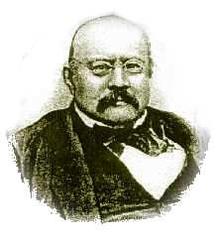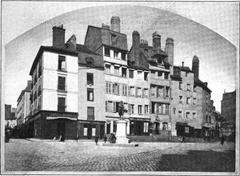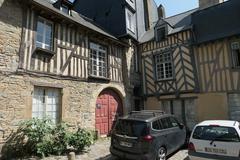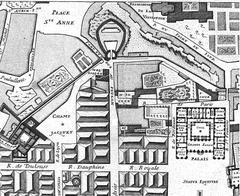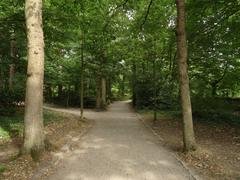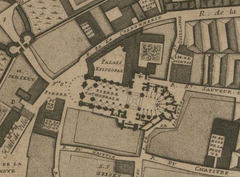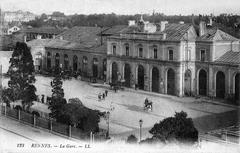
Hôtel de Cornulier Rennes: Visiting Hours, Tickets, and Historical Significance
Date: 04/07/2025
Introduction
Nestled in the historic heart of Rennes, France, the Hôtel de Cornulier stands as an emblem of 18th-century aristocratic elegance and regional civic heritage. Originally constructed for the prominent Cornulier family, this hôtel particulier has evolved from a noble residence to a vital administrative hub, now serving as the official residence of the Prefect of Brittany and Ille-et-Vilaine. The building’s architectural grandeur, rich historical layers, and beautifully maintained gardens make it an essential stop for visitors interested in Rennes’ cultural and historical tapestry (franco.wiki; Rennes Infos Autrement).
Although access to the interior is limited due to its governmental function, the Hôtel de Cornulier opens its doors to the public during special cultural events such as European Heritage Days, offering rare opportunities to explore its lavish salons and tranquil gardens. Its location—within walking distance of sites like Parc du Thabor, the Parlement de Bretagne, and the Musée des Beaux-Arts—makes it a prime starting point for exploring Rennes’ historic center (rennes-tourism.com; try-travel.com).
Contents
- Historical Overview
- Origins and Early Ownership
- Role as the Intendant’s Residence
- Changes During and After the French Revolution
- 19th & 20th Century Developments
- Architectural Context and Features
- Façade and Exterior
- Interior Layout
- Innovations and Urban Influence
- Visiting Information
- Visiting Hours & Access
- Tickets & Entry
- Accessibility & Getting There
- Nearby Attractions
- The Gardens
- Cultural and Civic Significance
- Visitor Tips and Highlights
- Preservation and Community Engagement
- FAQ
- Plan Your Visit
- Conclusion
- Sources
Historical Overview
Origins and Early Ownership
The Hôtel de Cornulier traces its roots to the 18th century, originally commissioned as a private residence for the influential Cornulier family—a noble lineage integral to Brittany’s social and political fabric. Around 1770, the City of Rennes acquired the property from the Comte de Cornulier, marking its transition from private aristocratic residence to a building of civic importance (franco.wiki).
Role as the Intendant’s Residence
Once acquired by the city, the hôtel particulier became the official residence of the Intendant of Brittany, a royal administrator overseeing regional finance, justice, and policing. This era placed the Hôtel de Cornulier at the center of Brittany’s governance during the waning years of the Ancien Régime.
Changes During and After the French Revolution
With the outbreak of the French Revolution in 1789, the building adapted to shifting political realities, becoming the seat of the prefecture for Ille-et-Vilaine. This transition symbolized the shift from royal administration to republican governance.
19th & 20th Century Developments
Throughout the 19th and 20th centuries, the Hôtel de Cornulier continued as the prefecture’s headquarters, later relocating its main offices to the Beauregard district. However, the building remains the official residence of the Prefect and is still used for important state functions and ceremonies (Wiki-Rennes).
Architectural Context and Features
Façade and Exterior
The Hôtel de Cornulier showcases the restrained elegance typical of 18th-century French urban architecture, with a symmetrical façade crafted from local stone, tall windows with wrought-iron balconies, and a grand entrance portal. The building’s classicism contrasts with the timber-framed medieval houses elsewhere in Rennes, emphasizing the city’s architectural evolution (Celtic Wanderlust).
Notable exterior features include:
- Evenly spaced windows with stone moldings
- Classical ornamentation such as pilasters and cornices
- An ornate entrance with wrought-iron detailing
Interior Layout and Decorative Elements
The interior—open to the public only during special events—features:
- A central courtyard, providing light and privacy
- Grand staircases with intricate ironwork
- Period salons with marble fireplaces, carved wood paneling, and decorative plasterwork
Recent restoration projects have preserved these elements, occasionally uncovering historical artifacts such as amphorae containing ancient coins, revealing the site’s deep historical roots (Waymarking).
Architectural Innovations and Urban Influence
The Hôtel de Cornulier is emblematic of the urban renewal that followed the 1720 fire in Rennes, reflecting classical ideals of symmetry, light, and space. Its integration into the urban grid, with street-facing façades and private courtyards, illustrates the city’s transition into Enlightenment-era sophistication.
Visiting Information
Visiting Hours & Access
- Regular Access: As an official government residence, the Hôtel de Cornulier is not open for daily public visits.
- Special Openings: Public access is available during events such as European Heritage Days (Journées Européennes du Patrimoine), usually held each September. Guided tours are sometimes offered during these occasions.
- Check Updates: Always confirm visiting hours and event dates on the Rennes Tourist Office website.
Tickets & Entry
- Standard Entry: No regular ticketing system exists, as visits are limited to special events.
- Events: Admission during open days is typically free, though guided tours may require advance registration.
Accessibility & Getting There
- Location: 1 rue Jean-Baptiste-Martenot, 35000 Rennes, France
- Transport: The nearest metro stop is Sainte-Anne (Line A), with public buses and parking available nearby (Rennes Infos Autrement).
- Accessibility: The main entrance and gardens are wheelchair accessible, but certain interior areas may have limited access due to the building’s historic nature.
Nearby Attractions
- Parc du Thabor: Renowned for its French and English gardens, aviaries, and rose garden
- Parlement de Bretagne: A symbol of regional judicial power
- Musée des Beaux-Arts: Home to a rich collection of European art
- Place des Lices: A vibrant square, especially on market days
The Gardens: A Hidden Gem
Behind the Hôtel de Cornulier lies a tranquil garden, accessible to the public during heritage events. Highlights include:
- A vegetable garden with heirloom varieties
- Fruit trees, greenhouse, beehives
- Terraced pathways bordered by historic walls The gardens reflect the building’s aristocratic origins and provide a serene retreat in the city (Rennes Infos Autrement).
Cultural and Civic Significance
The Hôtel de Cornulier has served as a residence for the region’s elite, a center of governance, and a venue for cultural events. Its preservation and adaptive use underscore Rennes’ commitment to heritage and civic engagement. The building’s role in hosting official ceremonies and special events strengthens its connection to both local identity and national history (POP: Plateforme ouverte du patrimoine).
Visitor Tips and Highlights
- Plan Around Events: Schedule your visit for European Heritage Days or other announced openings.
- Photography: Exterior photography is encouraged, but check for restrictions inside during events.
- Combine Visits: Pair your Hôtel de Cornulier visit with nearby attractions for a full day in historic Rennes.
- Guided Tours: Opt for guided tours during special openings for deeper insights into architecture and history.
- Accessibility: Contact organizers in advance if you have mobility concerns.
Preservation and Community Engagement
The Hôtel de Cornulier’s restoration is an ongoing collaboration between heritage authorities, local government, and the community. Educational programs, public events, and careful maintenance ensure the building remains a living part of Rennes’ heritage (Waymarking).
Frequently Asked Questions (FAQ)
Q: When can I visit the Hôtel de Cornulier?
A: Access is available mainly during European Heritage Days in September or other special events. Check the Rennes Tourist Office website for updates.
Q: Are tickets required?
A: Entry is generally free during open days, but some guided tours may require advance registration.
Q: Is the site accessible for visitors with reduced mobility?
A: The main entrance and gardens are accessible, though some areas may have limited access.
Q: Can I take photographs inside?
A: Photography may be restricted inside; always check with staff during your visit.
Q: How do I get there by public transport?
A: The nearest metro is Sainte-Anne (Line A); several bus lines also serve the area.
Plan Your Visit
To experience the Hôtel de Cornulier’s rich history and architecture:
- Check Rennes Tourist Office for special event dates and visiting information.
- Pair your visit with nearby sites like Parc du Thabor or the Musée des Beaux-Arts.
- Download the Audiala app for interactive guides and travel tips.
Conclusion
The Hôtel de Cornulier is more than a historical building—it’s a living testament to Rennes’ aristocratic heritage, architectural evolution, and civic life. Whether you visit during a special event or simply admire its façade and gardens, the experience offers a unique window into the city’s storied past. Combine your visit with other local attractions for a truly immersive exploration of Rennes.
Sources
- Hôtel de Cornulier in Rennes: Visiting Hours, Tickets, and Historical Insights, 2025, (franco.wiki)
- Visiting the Hôtel de Cornulier in Rennes: Hours, Tickets, and Historical Insights, 2025, (Rennes Infos Autrement)
- Exploring Hôtel De Cornulier: Architectural Marvel and Visitor’s Guide to Rennes Historical Site, 2025, (Celtic Wanderlust)
- Hôtel de Cornulier Visiting Hours, Tickets & History | Rennes Historical Sites Guide, 2025, (try-travel.com)
- Hôtel de Cornulier in Rennes: Architectural and Historical Insights, 2025, (Wiki-Rennes)
- Hôtel de Cornulier Restoration and Historical Discoveries, 2025, (Waymarking)
- Rennes Tourist Office Official Website, 2025, (rennes-tourism.com)
- Rennes Travel and Event Information, 2025, (loving-travel.com)



